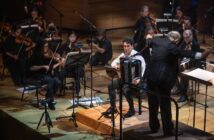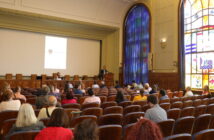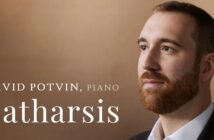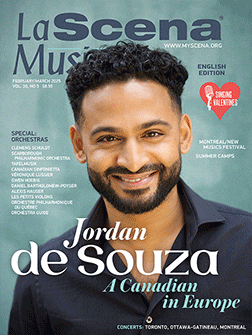
This page is also available in / Cette page est également disponible en:
![]() Francais (French)
Francais (French)
To understand the music of today, we need to know its beginnings, to understand the music of the 20th century in all its variety and heterogeneity. It is often a part of the musical history hidden from the general public, because it has suffered for several decades from limited media and institutional visibility. If Messiaen, Ligeti, Stockhausen or Schnittke were programmed as often as Beethoven or Tchaikovsky, the ear would surely be much more attuned to contemporary listening and receptive to the music of today.
By sweeping aside tonal language, that is to say, all Western music from Bach to Mahler or Debussy, the Second Viennese School opted in the years 1910-20 for a brutal but necessary revolution, because from the atonal bud have developed the main musical ramifications of the 20th century. Certain currents, like total serialism, have taken more radical and hermetic paths than others, contributing by their existence in isolation to distance the public and to give an elitist image to contemporary music. The reality is quite different; by reflecting quickly on a century of creativity, we realize the richness and diversity of languages that have evolved according to the personality of their creators.
The socio-cultural and technological upheavals of the 20th century made their mark on the world of musical creation: incessant and particularly lethal wars, interest in non-European languages and the arrival of electronic instruments push composers to redefine the notions of time and sound, in short, to return to the most essential aspects of music to question and explore them in a new way.
If the end of the century is an occasion to take stock, the beginnings of centuries bring with them renewal, as the musicologist Brigitte François-Sappey has shown so well in La musique au tournant des siècles. In 2019, it is time to give voice to those who shape the world of musical creation. In keeping with recent European publications (see the reviews section), La Scena Musicale is providing a platform for those who participate in the vitality of music in Quebec and Canada. They share their work with us and tell us about the relationship between contemporary music and its audience, the availability of youth to these sonic worlds and their perspectives for the future. La Scena Musicale is proud to support the music creation community by documenting these multiple voices. In our societies where everything seems written in advance, it’s time to regain a taste for risk and surprise!
Emmanuelle Lizère
For free access to the unheard
Emmanuelle Lizère holds a degree in music, musicology and art in therapy and psychopedagogy. Passionate about new music for more than 25 years, she conducts many creative and introductory workshops, both with children and adults in Canada and France, as part of the Vivier, Accès Culture, for various specialized musical ensembles, at Ircam, Musicora and Royaumont Abbey. She is currently artistic coordinator of Le Vivier. www.levivier.ca
The vitality of the music of creation is an undeniable reality with more than 300 concerts a year in Quebec, almost a concert a day. The variety of approaches, noisy, improvised, lyrical, electronic, contemporary or contemporary, proves the richness and possibilities of future developments. But today in Quebec, how to access these internationally recognized jewels (world tours of certain ensembles)? Their place on our airwaves or on our screens should be more available. Their discovery within educational institutions as a future cultural heritage should find its place in the arts. We could develop the listening and discovery of new works by allowing students to appropriate the world of creators of today. They are too difficult to access, wouldn’t you say? But children have an ear more open to new sound worlds than their elders, for whom often “music is this and nothing else.” At Le Vivier, we believe that these musics become accessible and arouse great enthusiasm among the public when it is immersed in the heart of the work, in the very process of composition, during meetings, participatory workshops of creation (involving participants of all ages) and concerts. It is when we accept to live these surprising sensory experiences, by opening ourselves to unheard sounds and new musical gestures, that we allow these musics to be part of the life of the general public.
Rachel Mercer
The Many Voices of Music
Principal cello of the National Arts Centre Orchestra since 2017, Rachel Mercer is a member of Ensemble Made In Canada, the Mercer-Park Duo and the AYR Piano Trio. She is also Artistic Director of the “5 at the First” Chamber Music Series in Hamilton. An advocate for new Canadian music, Rachel has commissioned more than 25 solo and chamber works, including the recording Sounds of Our Time on the Naxos Canadian Classics series and the Juno-nominated Piano Quartet by John Burge. www.rachelmercercellist.com
We go to concerts for many different reasons, whether to find beauty and comfort, to be stimulated, to be touched on a deep level, or just to escape ordinary day-to-day life. Contemporary music is a part of that, whether hearing new songs by a favourite artist, original jazz tunes, or a performance by Inuk throat singer Tanya Tagaq.
But in the traditional classical world, the word “contemporary” still sparks some displeasure, simply from the notion that classical contemporary music is ugly and incomprehensible. Yes, there is music, old and new, that doesn’t follow traditional ideas of beauty and is a challenge to understand, but “contemporary” just means of our time and in our time. With the global communication of information and blurred lines, there are countless styles and forms in music.
My job as a performer and programmer is to expose audiences to the many voices that exist in music today. And I have found that audiences new to classical music, just like us as children, are completely open to contemporary music. There is a sense of discovery and wonder, with open ears and minds. Yes, sometimes you want to go hear the exquisite classics, just like wanting to rock out to the oldies, but it is also exciting to be hearing a work for the first time, experiencing it alongside your fellow audience members. That shared experience is the heart of live performance and can only lead to a greater understanding of the music, and each other.
Guillaume Bourgogne
Time to listen
Artistic director of the Ensemble Op.cit and the McGill Contemporary Music Ensemble as well as music director of Ensemble Cairn and Camerata Aberta, Guillaume Bourgogne regularly performs as guest conductor with the Ensemble Intercontemporain, the Gulbenkian Orchestra, the Orchestre Régional de Normandie, L’Itinéraire, Contrechamps, Court-Circuit and the Israel Contemporary Players. Bourgogne teaches at the Schulich School of Music at McGill University. www.guillaume-bourgogne.com
Music, as the art of sounds and the art of time, is defined as a quest for new and unheard sound territories. Perhaps above all else, music transforms our listening. Listening to music itself, certainly, but creative music also changes the way we listen to the world. Spectral music composers have taught us to listen closely to the resonance of a bell, for example; Varèse allowed us to “hear” the space, Messiaen to be more attentive to the songs of birds. Since Cage, we are interested in silence and since Scelsi, intimacy of sound …
Some will say: it interests very few people … But, au contraire, everyone is affected, most often unconsciously. The music of art diffuses, with time and through our veins, other ways of listening, other qualities of listening. Audiovisual productions and media are seizing the progress of this famous “quest for the unheard” and are one of the ways of transmission.
Contemporary music is an adventure in sound. The great explorers of the past are not legion, but their discoveries concerned, and still concern, everyone. But to go on an adventure is necessarily to leave one’s comfort zone. In a world where the picture is omnipresent, where time is contracted and speed overvalued, musical creation is a step aside, a critical position for the younger generation.
Today, it is imperative to think about the climate issue, also question of temporality (long time versus short time), but also the otherness, in this elastic world where the communication has become prodigiously fast, but in which the question of the terrestrial borders is raised again. For that, a listening of the continously renewed world is more than ever necessary.
Vivian Fung
Motherhood and the Creative Process
The full article was originally published on www.musiconmain.ca. You can find it HERE.
Born in Edmonton, JUNO Award-winning composer Vivian Fung has a unique talent for combining idiosyncratic textures and styles into large-scale works that reflect her multicultural background. She has a deep interest in exploring cultures through travel and research. Among her many awards and grants are the 2015 Jan V. Matejcek New Classical Music Award, a Simon Guggenheim Foundation Fellowship, and grants from SCAP, BMI, American Music Center and Canada Council for the Arts. She lives in California. www.vivianfung.ca
I have not always wanted to be a mother. When I was 19 and highly impressionable, my then-mentor David Diamond offered this advice: “You will have to choose, Vivian: either you will have a wonderful life as a composer, or you will have babies.” Being entirely green, I proceeded through life with the intention of being childless and focused on the singular pursuit of a composing career.
Life changes. I encountered a wonderful, supportive life partner with whom I gradually came around to wanting to start a family. It was truly a conflicted time for me, since my life was already resolutely devoted to music.
In fact, not having as much time or space can be beneficial for creativity. Having a child has made me realize that life is indeed messy, and I have learned to trust my instincts and doubt less. Adopting a new rhythm took some time to get used to, especially all the starting and stopping, but I have learned to go with the flow and cherish the moments I have to write and daydream. Furthermore, seeing the world through my son’s eyes has completely rocked my world. He has opened me to feelings of compassion, joy and connection, as well as being my teacher on how to set boundaries, be persistent, flexible and, above all, patient.
I am writing this article in hopes of giving other artists and composers, both male and female, who are considering starting families the affirmation that it is possible to do both. I think a few baseline requirements are nearly essential – first, a partner who is willing to share in the responsibilities of raising a child; second, sufficient resources for childcare; third, a separate workspace, even if it is just a corner in a back room, to divide work from family life; and finally, above all, the continuing desire to create and work.
Véronique Lacroix
Who’s afraid of contemporary music ?
The Ensemble contemporain de Montréal (ECM+) founded in 1987. Passionate about music creation, Lacroix has discovered dozens of young composers whom she introduced to the Canadian public in the Génération tours that have been travelling the country since 2000. Constantly looking for innovative ideas to present the works to the general public, she favours an approach favouring “total art” where the audience lives a multisensory experience conducive to the reception of new ideas and sounds. www.ecm.qc.ca
Perhaps the most mysterious of all artistic disciplines, music has the magical power to envelop us, to capture both our emotions and our body, to transport us into an imaginary place that’s unexpected, before gradually revealing the fabric of its meanders that catch us, grab us … Even if it unfolds to different degrees and in different areas of our brain according to the compositions and styles, all music has this power and contemporary music does not escape this rule. But what is special about it? Why take the time to discover it under its sometimes enigmatic finery?
Just like life, contemporary music is constantly evolving, at once complex and simple, organized and unpredictable, with surges of beauty and impenetrability. To listen to it is to tame a construction that can be rigorous, while offering the path to its own liberation. It is to look at a horizon turned at once towards the past and the future, which combines emotion with reason while perpetuating the mystery of creation.
While it is still relatively utopian to reach a large audience with music that cannot be summed up in a single listening, it is possible to “touch” the novice listener by revealing these initiating links that underlie it, which bring the composer to his quest and the listener to his own life.
Therefore, the multidisciplinary, the “thematic” concerts and the setting in context of the works, as practiced by the ECM +, for example, or any other approach which gives the listener a grip to his experience or his thoughts are all ways to surrender to a demanding musical creation, but also a source of vital inspiration. This is what music is!
Louise Bessette
Live the music of today
 Member of the Order of Canada, Officer of the National Order of Quebec and Ambassador of the Canadian Music Center, pianist Louise Bessette is the recipient of nine Opus Awards and numerous international awards and received an honorary doctorate from the University of Western Ontario. In 2015, CBC Music named her one of Canada’s Top 25 Classical Pianists. She leads a piano class at the Conservatoire de musique de Montréal since 1996. www.louisebessette.com
Member of the Order of Canada, Officer of the National Order of Quebec and Ambassador of the Canadian Music Center, pianist Louise Bessette is the recipient of nine Opus Awards and numerous international awards and received an honorary doctorate from the University of Western Ontario. In 2015, CBC Music named her one of Canada’s Top 25 Classical Pianists. She leads a piano class at the Conservatoire de musique de Montréal since 1996. www.louisebessette.com
How did I become interested in contemporary music to such an extent that it represents most of my musical activity? During my studies at the Conservatoire de musique de Montréal, I had the privilege of continuing my musical journey with Georges Savaria and Raoul Sosa, who were open to the repertoire of all eras. At fourteen I was playing Berg’s Piano Sonata and Pépin’s Trois pièces pour la légende dorée. Then Raoul Sosa led me on the path of discovery to Olivier Messiaen.
Musical literature with Micheline Coulombe Saint-Marcoux and musical analysis with Gilles Tremblay also opened the way to the music of our time, which was not a difficult apprenticeship for me, because I never perceived it as a music apart, isolated. It represents the evolution of musical writing and thought. The listeners must welcome it with simplicity, curiosity, openness. To tame it, I encourage the public to go to concerts. Listening to a symphony of Brahms, Hétu or Ives in the living room is a rewarding experience, but what is more beautiful than living the music by feeling the energy and emotion conveyed by the performers? To see a painting by Riopelle in a beautiful book is already something, but to observe the original that is there before our eyes gives an intense emotion!
Preconcert discussions where performers and composers present their approach and the context of the works are also valuable listening tools. Together, let’s share the path of musical and human evolution!
Claire Marchand
The 21st Century and the quest for identity
Acclaimed by critics for the “subtlety of colors, technique and virtuosity,” flutist Claire Marchand is the recipient of an Opus Award in Quebec for concert of the year in contemporary music and has recorded albums released by ATMA and Analekta. Claire Marchand continues her career as a flutist, working regularly to create new works with composers. She has been the General and Artistic Director of the Canadian Music Centre in Quebec since 2015. www.clairemarchand.net / www.cmcquebec.ca
As a flutist and performer for 30 years, I participated in a large number of premieres. In addition, as general director of the Canadian Music Centre in Quebec, every year I see a dozen new composers who wish to be part of our organization so that they can make themselves better known by adding their works in our catalogue.
Talented and versatile young composers try to stand out among the great family of contemporary music. We feel this movement inspired by all the sound palettes developed during the last century.
In fact, I hear more and more of a variety of styles and approaches, as the possibilities brought by new technologies mean that composers are called to develop (sometimes accelerated) a new language and to create a style, an identity.
At the beginning of this century, local composers have the mission to participate fully in the cultural and musical identity of our country. Nobody is a prophet: who would have thought that the 20th century would have given birth to music without frontiers and to movements like dodecaphonism, electroacoustics and minimalism?
The mission of the Canadian Music Centre is to ensure that our new music is heard now and preserved for posterity. Our dearest wish is that local composers participate fully in the development of new languages and musical styles that will mark the music of tomorrow. www.musiccentre.ca
Walter Boudreau
The unique SMCQ
Composer and conductor Walter Boudreau has composed more than 60 works for various forces in addition to a number of scores for film, theater and ballet. Artistic Director of the Society of Contemporary Music of Quebec (SMCQ) since 1988, over the years he has launched unique projects that have helped to anchor the institution in the Canadian cultural community, including the international festival Montréal/Nouvelles Musiques and the Tribute series. Among other distinctions, he is Chevalier of the National Order of Quebec and a member of the Order of Canada. www.smcq.qc.ca
Following its 50th anniversary, the 52nd season of the SMCQ reached a record of influence and attendance. Reaching more than 77,000 people in the tribute series dedicated to the composer José Evangelista, the organization was able to reaffirm its fundamental importance in the creative sector by bringing together institutions, organizations and individuals from the worlds of new and classical music, the visual arts and media around a composer from here.
This tendency to favour collaborations is one of its greatest strengths, in the current context of diversification and distribution of artistic offering. The SMCQ is unique in that it is not an ensemble or an orchestra, but an organization that puts all its infrastructure, its resources, the expertise of its artistic direction and its team for the benefit of the entire community.
Over the years, the SMCQ has undergone remarkable development, becoming one of the strongest institutions devoted to contemporary music. It has acquired this privileged status through the establishment of major unifying and recurring events, including the Montréal/Nouvelles Musiques international festival, alternating with the Tribute Series in addition to a youth component with incomparable dynamism. These activities illustrate the SMCQ’s ability to adapt to the changes in the cultural context that have occurred over the last 50 years, including the proliferation of ensembles and organizations dedicated to contemporary music.
Anxious to be in tune with the creators of her time, it has commissioned, created and recorded several essential works of the contemporary repertoire from home and abroad, including the unforgettable Millennium Symphony. The quality, diversity and scale of its activities allow it to meet the challenge, season after season, of bringing together a surprisingly large audience in the relatively small niche of contemporary music.
Pierre-Olivier Roy
New music
Composer Pierre-Olivier Roy has a career in the creation of new music and audio production, mainly for concert msuic. His body of work consists mainly of chamber music (instrumental and mixed) and electroacoustic works. Very active in the field of new music, he manages the general and artistic direction of E27 musiques nouvelles and teaches at the Faculty of Music of Laval University and the Campus Notre-Dame-de-Foy. www.pierreolivierroy.ca
New music. In its most spirited gestures, but also in its most subtle restraints, in minimalist forms as in dense textures, the genres have in common the presentation of a sensitivity and a virtuosity we do not always expect from them. They come in a thousand and one ways. They offer singular avenues for appreciation and different ways of approaching the sound. They change their forms, they evolve, they seek. They are exploratory, sometimes mild and sometimes arduous, but always audacious, curious and exciting.
I refuse to have to justify the fact that new music is difficult to approach. Tastes are varied, but I am convinced that the range of new music is wide enough. Within E27 musiques nouvelles, we strive to present a wide range of these iterations of new music from contemporary repertoire to recent music. From chamber music to audiovisual installations, there is something for everyone. The challenge remains the same when we talk about dissemination of the arts, we just need to pique the curiosity.
My experiences in teaching and youth activities at E27 suggest or confirm that children and young adults have a great openness to musical audacity. Of course, they often consume something else, but let’s not forget that art music does not have a monopoly on risk. Audiences are curious, let’s be open. Young people will not have blinkers if we wake them up. The environment is dynamic, let’s go to meet them.
Jeffrey Stonehouse
Curiosity and an Open Mind
Flutist Jeffrey Stonehouse is artistic director and co-founder of Ensemble Paramirabo, one of Montreal’s most active contemporary chamber ensembles. He maintains a busy career as a soloist and orchestral and chamber musician. He has performed with such top ensembles as ECM+, SMCQ ensemble and the Nouvel Ensemble Moderne and has performed across Canada, the United States and Europe. Jeff has premiered more than a hundred solo and chamber works and is a winner of the soundSCAPE International Festival Performer Prize. He teaches at the CEGEP de Drummondville. www.jeffreystonehouse.com
How can contemporary music find a larger pool of listeners? The first very important step is to de-institutionalize contemporary music. Many listeners associate contemporary music with being either “weird” or requiring a very specific educational background to understand it. This is not true. The only prerequisite is an open mind.
Many new works are direct reflections of today’s society. Through collaborations with other disciplines (visual arts, theatre, dance) or concerts staged in alternative spaces, the listener can be brought into appreciating what would perhaps normally be a more “challenging” listening experience. I also think it’s important that we not become obsessed with commercializing contemporary music. Perhaps it’s acceptable that we have smaller audiences than rock concerts.
Must we, and how can we, educate young people taste for contemporary music? Young ears are curious ears. I think if we begin exposing young audiences to contemporary music early, they are more likely to get hooked as adult listeners. Encouraging play and interactive listening experiences is key. During the recent Ensemble Paramirabo performance of an opera by composer Gabriel Dharmoo, I had the opportunity to experience this first-shand during cultural mediation workshops that Gabriel and I conducted. After getting over the initial shock of how bizarre their voices could sound, the groups of secondary students clearly enjoyed playing and experimenting with composing their own work. For younger children, contemporary music is even more accessible as they do not yet have pre-formed ideas of what music has to be.
This page is also available in / Cette page est également disponible en:
![]() Francais (French)
Francais (French)
























